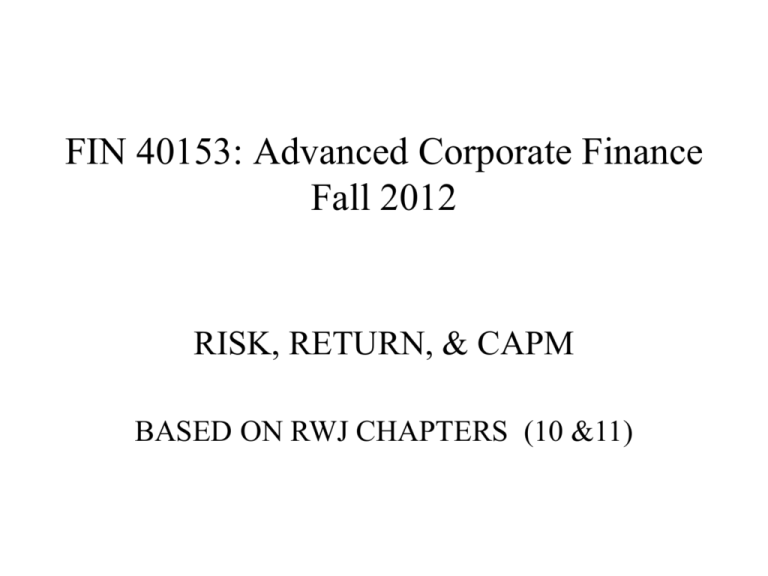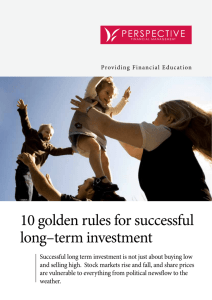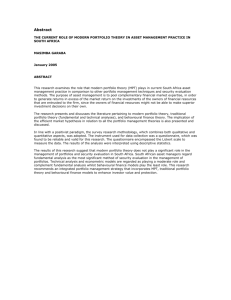
FIN 40153: Advanced Corporate Finance
Fall 2012
RISK, RETURN, & CAPM
BASED ON RWJ CHAPTERS (10 &11)
How are risk and expected return related?
There is general agreement that average returns should increase
with risk.
Average
Return
Risk
But, how should risk be measured? At what rate does the line
slope up? Is the relation linear?
Lets look at some key historical evidence.
The Accumulated Value of $1 Invested in 1926
$1 (1 r1926 ) (1 r1927 ) (1 r2002 ) $1775.34
1000
$59.70
$59.70
$17.48
10
Common Stocks
Long T-Bonds
T-Bills
0.1
1930
1940
1950
1960
1970
1980
1990
2000
Source: © Stocks, Bonds, Bills, and Inflation 2003 Yearbook™, Ibbotson Associates, Inc., Chicago (annually updates work by
Roger G. Ibbotson and Rex A. Sinquefield). All rights reserved.
Rates of Return 1926-2002
60
40
20
0
-20
Common Stocks
Long T-Bonds
T-Bills
-40
-60 26
30
35
40
45
50
55
60
65
70
75
80
85
90
95
'00
Source: © Stocks, Bonds, Bills, and Inflation 2003 Yearbook™, Ibbotson Associates, Inc., Chicago (annually updates work by
Roger G. Ibbotson and Rex A. Sinquefield). All rights reserved.
How Can We Assess Risk?
Many people think intuitively about risk as
the possibility of an outcome which is
worse than anticipated.
For those who hold more than one asset, is
it the risk of each asset they care about, or
the risk of the portfolio?
Historical Volatility and Return for 500
Individual Stocks by Size
Appears to be a relation between portfolios volatilities and returns but no precise relationship between
volatility and average return for individual stocks. Individual stocks have higher volatility and lower
average returns compared to large portfolios. WHY?
Risk and Probability Distributions
The Expected Return Is A Weighted Sum Of The Possible
Returns, where Each Return Is Weighted By Its Probability Of
Occurrence, p.
n
Expected Re turn E[ R] Ri pi
i 1
The Variance of Returns Measures the dispersion of returns
around the expectation.
n
Variance 2 pi ( Ri E[ R]) 2
i 1
The Standard Deviation (STD or ) Is The Square Root Of
The Variance. It Is In The Same Units As The Returns
Calculating Sample Statistics
What if we don’t know the probabilities. We can estimate the
variance and expected return using the arithmetic mean of past
returns and the sample variance.
We can use historical data
Mean = R = (R1 + R2 + R3 + ... + RT)/T
Sample Variance = 2 = "Average" of [RT - R]2
_
1 T
2
Var
(R
R
)
t
T 1 t 1
2
Risk and Return in Portfolios
When we have more that one asset (i.e. a portfolio)
risk and return are more complex. We will show that
there are two kinds of risk:
Diversifiable/idiosyncratic/nonsystematic risk
Nondiversifiable/systematic risk
We can eliminate diversifiable risk by carefully
combining assets into portfolios.
It is usually possible to improve the risk return
tradeoff by diversifying.
Amazon vs. S&P 500
Covariances and Correlations: The keys to
Understanding Diversification.
• When thinking in terms of probability distributions, the
covariance between two assets’ (A and B) returns is
Covariance = Cov(AB) = AB=
n
(R
Ai
- E[R A ])(R Bi - E[R B]) pi
i =1
• When estimating covariances from historical data, the
estimate is given by:
T
1
( R Ai - R A )(R Bi - R B)
T 1 i =1
Correlation Coefficients
• Covariances are difficult to interpret. Is a covariance of 20
big or small? The correlation coefficient is a normalized
version of the covariance given by:
• Correlation = CORR(A,B) = Cov(AB) = AB
A B
A B
• The correlation will always lie between 1 and -1.
– A correlation of 1.0 implies ...
– A correlation of -1.0 implies ...
– A correlation of 0.0 implies ...
Risk and Return Example:
Two Assets, A and B
A portfolio, P, comprised of 50% of funds in A and 50% of funds
in B.
Only five equally probable future outcomes, summarized below.
Probability
0.2
0.2
0.2
0.2
0.2
E(Return)
A
18
30
-10
25
17
16
Return (%)
B
25
10
10
20
-5
12
P
21.5
20
0
22.5
6
14
In this case:
VAR(A) = 191.6 and STD(A) = 13.84.
VAR(B) = 106.0 and STD(B) = 10.29.
COV(A,B) = 21
CORR(A,B) = 21/(13.84*10.29) = .1475.
VAR(P) = 84.9 and STD(P) = 9.21 -- less than either component!
In general for portfolios
The expected return on a portfolio is the
weighted average of the expected returns on
each asset. If xi is the proportion of the
portfolio in asset j, then
n
E[ R p] = w i E[R i]
i =1
Note that this is a ‘linear’ relationship.
Variance of a Two-Asset
Portfolio
For a portfolio of two assets, A and B, the
portfolio variance is:
Portfolio Variance p = w2A 2A + w2B 2B + 2 w A wB AB
2
or,
Portfolio Variance p = w2A 2A + w2B 2B + 2 w A wB corr ( A, B) A B
2
For the two-asset example considered above:
Portfolio Variance = .52(191.6) + .52(106.0)
+ 2(.5)(.5)21
= 84.9 (check)
The Variance of an n-asset Portfolio
2 = w w cov(R R ) + w w cov(R R ) + w w cov(R R ) +…+ w w cov(R R )
P
1 1
1 1
1 2
1 2
1 3
1 3
2 1
2 1
+ w2w2cov(R2R2) + w2w3cov(R2R3) + … + w3w1cov(R3R1) +
w3w2cov(R3R2) + w3w3cov(R3R3) + ….
When i = j the cov(Ri, Rj) = var(Ri)
So there will be n variance terms and n2 – n covariance terms
when calculating the variance of a portfolio
Consider the two asset case again ( N = 2) and wi , j = 1/2
2
p
= (1/2)2 cov(R1, R1) + (1/2)(1/2)cov(R1, R2) + (1/2)(1/2)cov(R2, R1) + (1/2)2 cov(R2, R2)
= (1/2)2 var(R1) + (1/2)2 var(R2) + 2(1/2)(1/2)cov(R1, R2)
Same as previous slide
Risk in n-asset Portfolios
1
2
= 2
P n
2
i
i
n variances - one per
asset
+
1
n2
cov( R R
i
i
j
)
j
(n2 – n) covariances - one between
each pair of assets.
What happens when the number of risky assets in the
portfolio, n, becomes large?
This is easiest to demonstrate if we assume:
that all the assets have the same variance of return, VAR.
The covariance between each pair of assets is the same, COV.
The portfolio is equal-weighted (each asset has a weight 1/n)
Then, Portfolio Return Variance is: (1/n)VAR + (1 - 1/n)COV
What happens if n approaches infinity? Graphical Illustration:
Portfolio Variance
What happens when the number of assets
in the portfolio, n, becomes large?
120
100
80
60
40
20
0
CORR=1.0
CORR=0.5
CORR=0.25
CORR=0.0
0
20
40
# of Assets
60
DIVERSIFICATION ELIMINATES UNIQUE
RISK
Portfolio
standard
deviation
Nonsystematic risk
Systematic/Market risk
5
10
Number of
securities
Diversification
Diversification reduces risk. If asset returns were
uncorrelated on average diversification could eliminate
risk. But, they are actually positively correlated on
average.
Diversification will reduce risk but will not remove all
of the risk. So,
There are two kinds of risk
Diversifiable/nonsystematic risk
Disappears in well diversified portfolios
Nondiversifiable/systematic risk
Does not disappear in well diversified portfolios
Summary statements regarding risk and return
for a portfolio. We will show:
(i) The expected return on a portfolio is always a weighed
average of the expected returns on the portfolio's
components.
(ii) The risk of a portfolio's return, as measured by
standard deviation, is generally less that the weighted
average of the risks of the portfolio’s components .
(iii) Risk generally declines when new assets are added to
a portfolio. Risk declines more:
The lower the new asset's standard deviation,
The lower the correlations between the new asset's
payoffs and payoffs to the various existing assets.
Nonsystematic/diversifiable risks
Examples
Firm discovers a gold mine beneath its property
Lawsuits
Technological innovations
Strikes
The key is that these events are random and
unrelated across firms. Some surprises are
positive, some are negative. On average, the
surprises offset each other
BIOGEN and MS Drug Failure
Eli Lilly Lawsuit with Ariad
Share Price Falls about $0.50 on Announcement (Close to
Open). $0.50 x 1B Shares Outstanding = $500M
Ariad Pharm
Stock Went Up By $2. $2 x 62 M Shares = $124 M
Systematic/Nondiversifiable risk
We know that the returns on different assets are positively
correlated with each other on average. This suggests that
economy-wide influences affect all assets.
Examples:
Business Cycle
Inflation Shocks
Productivity
Interest rates
These are economic events that affect all assets. The risk
associated with these events is systematic, and does not
disappear in well diversified portfolios.
GE, DJI, S&P 500, & NASDAQ
Measuring Systematic Risk
How can we estimate the amount or proportion of an
asset's risk that is diversifiable or non-diversifiable?
Incremental risk a new asset adds to the risk of a portfolio
is through its Beta Coefficient:
Cov(R i , R M )
i
Var(R M )
As such, Beta is a measures of sensitivity: it describes
how strongly the stock return moves with the market.
Example: A Stock with =2 will on average go up
20% when the market goes up 10%, and vice versa.
Some Additional Insight: Restate Beta in
terms of correlations.
Since CORR(Ri,Rm) = COV(Ri,Rm)/STD(Rm)STD(Ri), the market beta
can be restated as:
i = STD(Ri)CORR(Ri,Rm)/STD(Rm).
Interpret the components this way:
STD(Ri) is a measure to the total risk of asset i.
CORR(Ri,Rm) is a measure of the proportion of asset i's risk that is
systematic.
STD(Ri)CORR(Ri,Rm) measures the systematic risk of asset i.
STD(Rm) measures the total risk of the market, all of which is
systematic.
So, i is the systematic risk of asset i, relative to the systematic risk of
the market.
This also implies that the average of all betas is 1.0
What is Home Depots Beta?
Negative Beta
Citigroup Inc
Betas and Portfolios
Also, the Beta of a portfolio is the weighted average of the
component assets’ Betas.
Example: You have 30% of your money in Asset X,
which has X = 1.4 and 70% of your money in Asset Y,
which has Y = 0.8.
Your portfolio Beta is:
P = .30(1.4) + .70(0.8) = 0.98.
Why do we care about this feature of betas?
It implies that beta measures the contribution of
each asset to the risk of a well-diversified
portfolio!
Betas for selected common stocks
(based on monthly data for 2000 – 2005)
Industry
Beta
Ticker
Firm
Beta
Gold & Silver
-0.04
NEM
Newmont Mining Corp
0.02
Personal & Household Products
0.25
PG
Proctor Gamble
0.19
Utilities
0.48
EIX
Edison International
0.50
Restaurants
0.69
SBUX
Starbucks Corp
0.60
Retail Grocery
0.74
SWY
Safeway
0.67
Forestry & Wood Products
0.95
WY
Weyerhaeuser Company
0.96
Recreational Products
1.00
HDI
Harley-Davidson Inc
1.14
Apparel
1.12
LIZ
Liz Claiborne Inc
0.90
Auto & Truck Manufacturers
1.44
GM
General Motors
1.20
AAPL
Apple Computer Inc
1.35
Computer Hardware
Software and Programming
1.74
ADBE
Adobe Systems
1.84
Computer Services
1.77
YHOO
Yahoo! Inc
2.80
Communications Equipment
2.20
CSCO
Cisco Systems Inc
2.28
Semiconductors
2.59
AMD
INTC
Advanced Micro Devices Inc
Intel Corporation
3.23
2.17
The Capital Asset Pricing Model (CAPM)
Given that
some risk can be diversified,
diversification is easy,
most investors do diversify,
What is the equilibrium relation between risk and
expected return in the capital markets?
The CAPM is the best-known and most-widely
used equilibrium model of the risk/return relation.
CAPM Intuition
E[Ri] = RF (risk free rate) + Risk Premium
= Appropriate Discount Rate
Risk free assets earn the risk-free rate (think of
this as a rental rate on capital).
If the asset is risky, we need to add a risk
premium.
The size of the risk premium depends on the
amount of systematic risk for the asset (stock,
bond, or investment project).
Could a risk premium ever be negative?
The CAPM Intuition Quantified
Cov(R i , R M )
E[R i ] R F
[E[R M ] R F ] or,
Var(R M )
E[R i ] R F i [E[R M ] R F ]
Amount of Risk ()
Market Risk Premium
The expression above is referred to as the “Security
Market Line” (SML).
The Security Market Line
Expected Return (%)
SML: Ri = RF + i( E[RM] - RF )
RM
RF
1.0
Risk: i
Expected Rates of Return
Ticker
Firm
Beta
Expected Return
NEM
Newmont Mining Corp
0.02
4.2% + 0.20×5% = 5.2%
PG
Proctor Gamble
0.19
4.2% + 0.19×5% = 5.15%
EIX
Edison International
0.50
6.70%
SBUX
Starbucks Corp
0.60
7.20%
SWY
Safeway
0.67
7.55%
WY
Weyerhaeuser Company
0.96
9.00%
HDI
Harley-Davidson Inc
1.14
9.90%
LIZ
Liz Claiborne Inc
0.90
8.70%
GM
General Motors
1.20
10.20%
AAPL
Apple Computer Inc
1.35
10.95%
ADBE
Adobe Systems
1.84
13.40%
4.20%
YHOO
Yahoo! Inc
2.80
18.20%
CSCO
Cisco Systems Inc
2.28
15.60%
AMD
INTC
Advanced Micro Devices Inc
Intel Corporation
3.23
2.17
20.35%
15.05%
Assumption Rf = 4.2% and MRP = 5%







